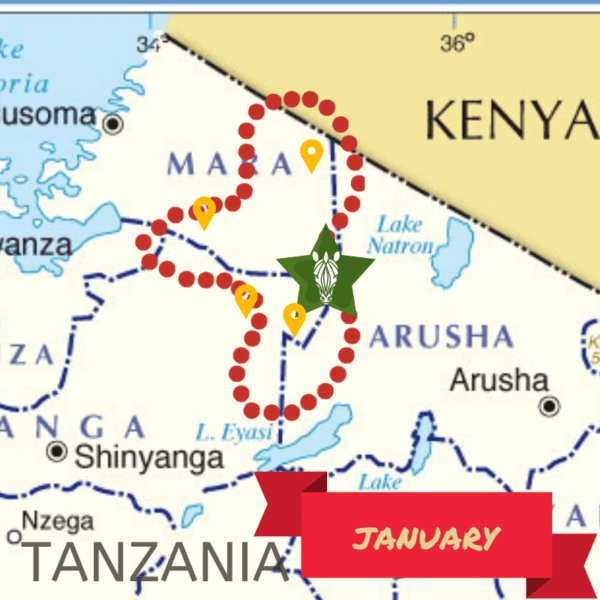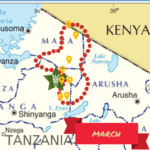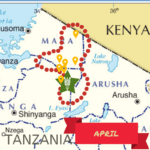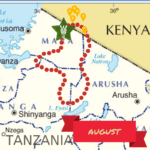There is nothing on earth that can match the sheer scale of East Africa’s legendary Great Wildebeest Migration.
Every true adventurer on our planet dreams of seeing this great migration through Africa for themselves at least once in their lifetime.
And when you learn a little more about wildebeest… the phenomenon that is the wildebeest migration becomes even more magical and downright astounding.
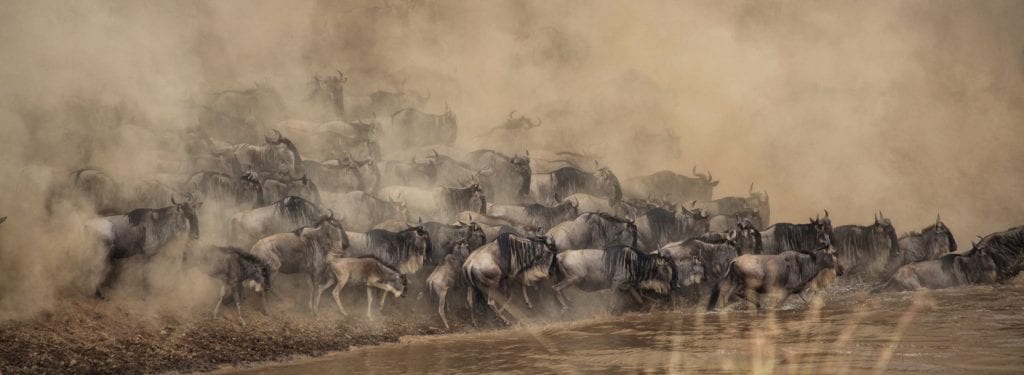 Image © Shripal Daphtary — unsplash.com
Image © Shripal Daphtary — unsplash.com
Wildebeest are not always migratory!
How about that!?
Black wildebeest are often nomadic but regularly have a small home range with different bulls holding down their own personal territory.
Blue wildebeest have both migratory and sedentary populations and all the other wildebeest you may see in the Ngorongoro and the Masai Mara are sedentary.
Migration remains unique to only a few wildebeest populations on earth.
One could almost blame the great wildebeest migration on their ‘sweet tooth’ as they seek to find grass with a high phosphorus and nitrogen content.
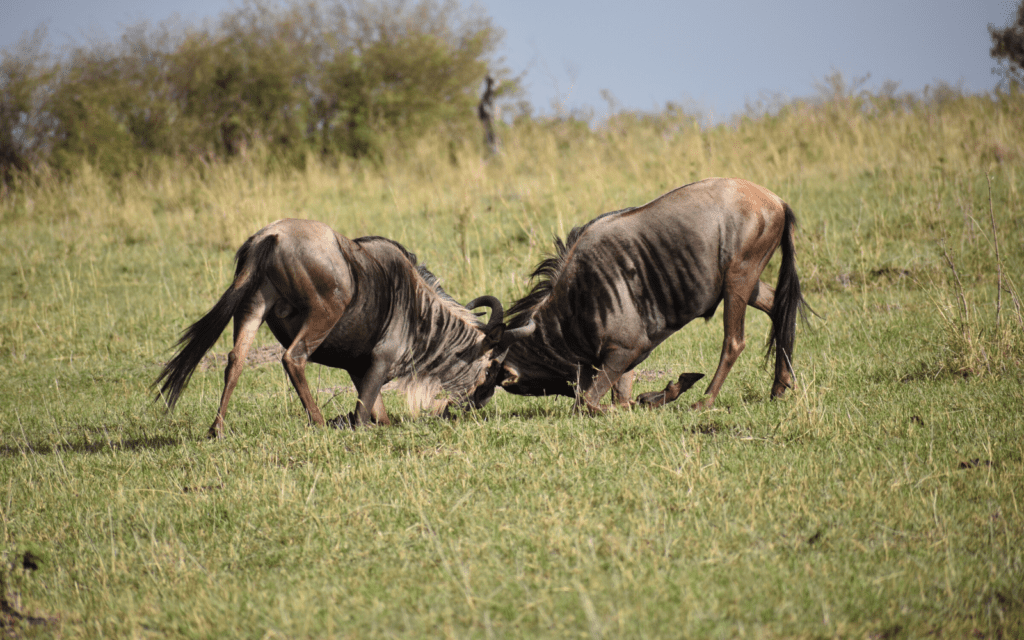 Image © Justin Porter — unsplash.com
Image © Justin Porter — unsplash.com
Africa’s Great Migration is the Greatest Show on Earth
In East Africa, the wildebeest and zebra follow in the footsteps of the rain.
As the long rain falls it soaks the ground through April and May. All this water turns the roads into unnavigable rivers of mud and many camps close out of necessity. In its wake, the rainy season leaves behind the blooms of delicious short grass. And that is what the wildebeest and zebra herds will move for.
They travel together as they eat different parts of the grass. Around July the herds may be in the northern Serengeti where their feast is rudely interrupted by the great rivers that form the border between the Serengeti and the Masai Mara.
Of course, wherever the migration goes, the predators can be found. Lion, hyena, African wild dog, cheetah, leopard, and crocodile are all ready for a feast… and they all seem to favor the wildebeest over any of the other animals on the migratory route.
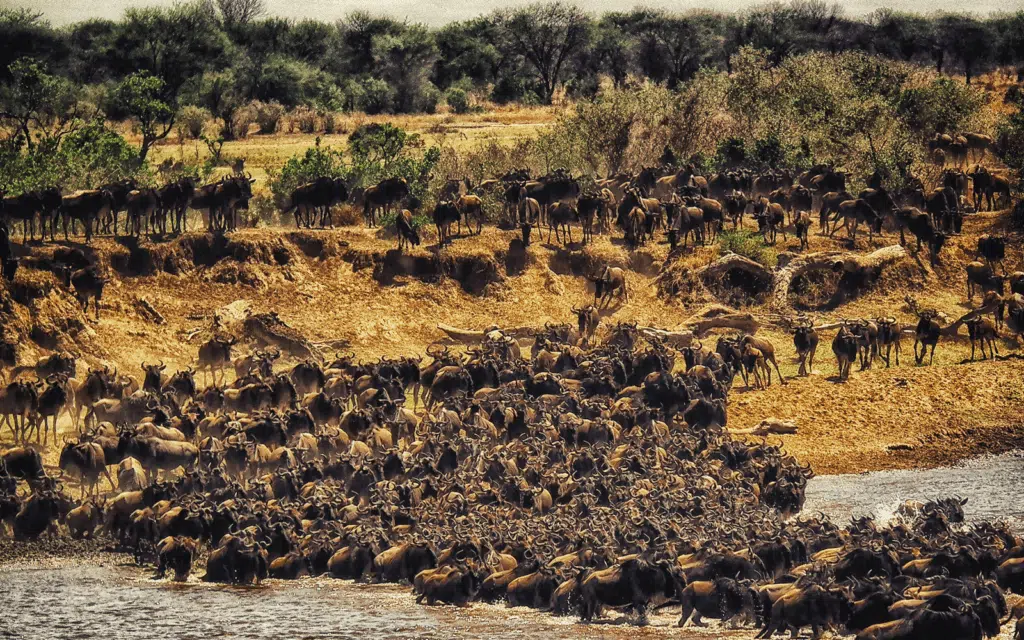 Image © Rohan Reddy— unsplash.com
Image © Rohan Reddy— unsplash.com
Undeterred, the wildebeest and zebra will now cross the rivers en masse…
This extravagant drama of survival that is the Great Migration river crossings? It is impossible to predict when the start gun will go off… herds may laze around the riverbanks for days while the crocodiles patrol the river patiently. Then, suddenly the herd will decide, as one, that the time has come to take on the great rivers of East Africa with all the steep banks, crocodiles and sweet victory it may entail.
Unless, of course, more rain falls before they can make their move. If this happens they may turn back to enjoy the convenient grass that had sprung up behind them before attempting to cross the border.
The migration is not the movement of a single herd. Instead, the animals congregate in mega herds of thousands or hundreds of wildebeest, zebra, and antelope. Together, all the animals participating in the Great Wildebeest Migration number around two million individuals.
For around 250,000 of the Great Migration will be a death march.
And still. Every year, for the last million years, they have done it.
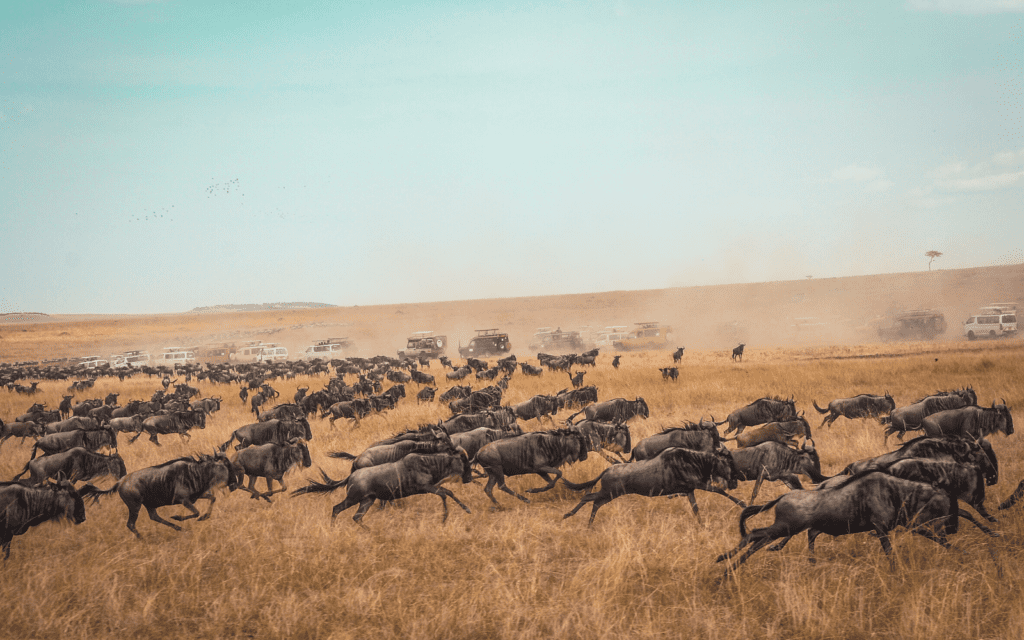 Image © Harshil Gudka — unsplash.com
Image © Harshil Gudka — unsplash.com
The Schedule is There is No Schedule
It turns out that the plains game do not print their itinerary for our convenience. In East Africa, there are no fences and the herds can move freely wherever the wind (or more likely the rain) takes them.
Why do they run?
Scientists are still finding the answers. The migration must be coded in their DNA. And it might happen in response to the nutrients in the new grass.
We do know that the wildebeest migration is bigger than any individual wildebeest. Aerial imagery suggests that the animals always move in an organized and undulating way. There is a fascinating ‘swarm intelligence’ at work here.
The mega herds travel in the same general direction (although they may do so along slightly different routes). All the members of every mega herd don’t spend all their time together. Some may scout a day or two ahead.
When mating season is done the animals who found themselves playing a lesser role may break off to join the lesser herd traveling through the Seronera Valley.
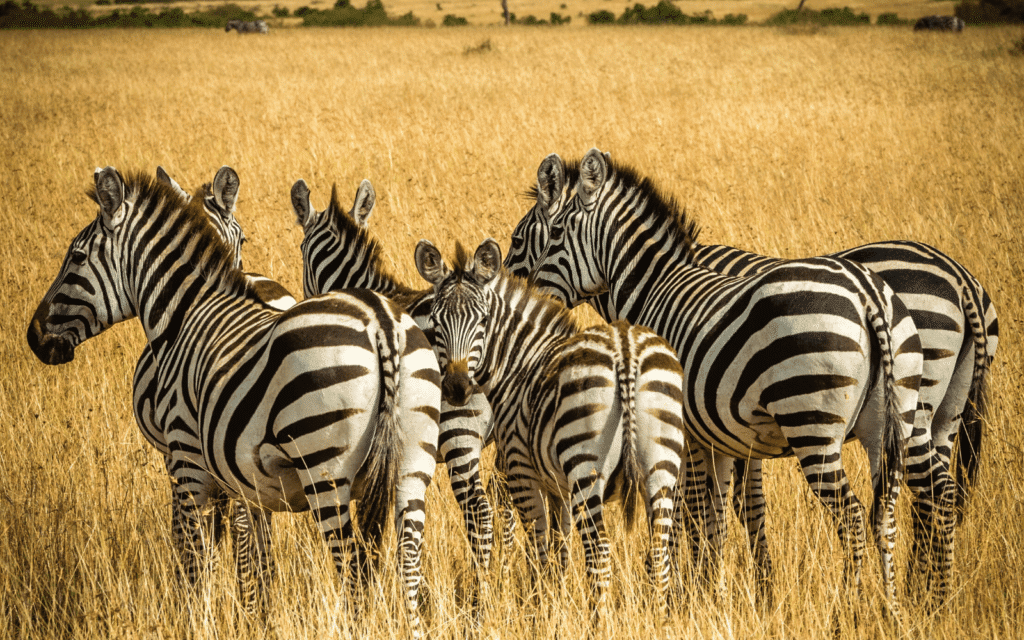 Image © sutirta budiman— unsplash.com
Image © sutirta budiman— unsplash.com
Ecological Importance, Threats and Conservation of the Great Wildebeest Migration
While the wildebeest have evolved sophisticated cooperative behaviors such as organizing a guarding and sleeping schedule and learning to interpret the alarm calls of other species like the baboon, the ones who do not survive are an important source of food, not only for the predators but also for the scavenging vultures that follow along. This means that the migration brings along a host of other, smaller creatures, including Thomson’s gazelles who favor the new-growth grasses stimulated by the main migration.
In the wake of the migration the soil fertility benefits and, of course, the migration is economically important as a major tourist attraction.
The grouping of the zebras and wildebeest also have a positive effect on giraffe calves surviving as the presence of all the preferred prey reduces giraffe predation.
The entire migration is dependent on large connected landscapes and as this becomes increasingly hard to maintain the wildebeest population is experiencing a rapid decline.
Fences and roads halt the migration and may prevent wildebeest from reaching water and grazing grounds (especially in Botswana).
Illegal hunting remains a major concern.
Where black and blue wildebeest share ranges they may hybridize and this is a threat to the black wildebeest.
Currently, while the population trend is stable although the numbers of the easter white-bearded wildebeest are in steep decline.
The best guarantee to see this wonder of the natural world is to use a Travel Designer who has one foot in East Africa and both ears to the ground.
The Great Wildebeest Migration by Month
J A N U A R Y
What is Happening
The new year arrives with great expectations in East Africa. It is calving season and the short rains may be falling, turning the Southern Plains of the Ndutu green. The soil is rich in phosphorus and we know the wildebeest find this irresistible.
The southern Serengeti and northern Ngorongoro Conservation Area – from Maswa to Gol, as far south as Kakesio, and as far north as the Moru Kopjes— is good for migration action.
At the start of the year, movement of the great migration in the Serengeti is very variable and completely dependent on the rain in the Southern Plains.
Under the most usual circumstances, the herds are now in the northeast of Tanzania’s Serengeti National Park and making their way back down to the Southern Serengeti, Lake Ndutu and the Ngorongoro Conservation Area.
Don’t Miss the Highlights
Calving starts. Peak birthing season is usually at the end of January and during the first two weeks of February when 400 000 births will take place over three weeks. As the females give birth, the need for new grass increases. The babies will be up to migration speed within 48 hours.
The highest concentration of predators is found. The lion prides will stalk the grazers from the marsh and woodlands and cheetah enjoy the hunting grounds of the wide-open plains.
Watch the complete circle of life unfold in front of your eyes.
Where to Sleep
East Africa is quieter and the herds may be anywhere from Lobo in the north to Ndutu in the south and they can move very quickly.
Serengeti Safari Camp⛺️ Serengeti Under Canvas⛺️ Ndutu Safari Lodge⛺️ Kusini Mobile
Combine your Great Migration African Safari with:
A visit to Lake Eyasi
End your safari in Zanzibar.
Go Gorilla trekking and double the once-in-a-lifetime quota in a single safari.
Hit the wine lands of Cape Town.
F E B R U A R Y
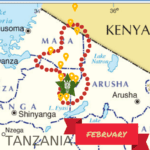 What is Happening
What is Happening
In February the prediction odds skew a little in our favor as we are pretty certain to find the migration in the lush Serengeti.
As the Southern Plains are devoured, herds wander west to Maswa Game Reserve or east and south into the Ngorongoro Conservation Area and In February the herd may be found between the Goll kopjes and Ndutu in the east and Olduvai Gorge. Kusini, Ndutu. Masek is very busy.
Don’t Miss the Highlights
Calving is in full swing with half a million wildebeest born during two to three weeks in late January and early February.
The rut is now generally underway and small dramas abound as the male wildebeest joust for the right to court the ladies.
Where to Sleep
Serian’s Serengeti South⛺️ Serian’s Kusini Mobile⛺️ Serengeti Under Canvas⛺️ Serengeti Safari Camp⛺️ Ndutu⛺️ Olakira⛺️ Kimondo⛺️ Ubuntu⛺️ Dunia Camp⛺️ Kusini⛺️ Pioneer Camp⛺️ Mwiba
Combine your Great Migration African Safari with:
Visit Mocambique for a stunning beach holiday.
Enjoy the best time of the year in gorgeous Cape Town.
Go trekking for Gorilla in Uganda or Rwanda.
M A R C H
What is Happening
The grasslands are lush and green, providing good sustenance for the new arrivals who (like most new arrivals on earth) like to feed constantly. Intensive grazing will soon start to take its toll.
The migration is now concentrated in the Ndutu region as well as the Southern Serengeti and Ngorongoro Crater. From Maswa in the west to Gol in the east. And in Kusini.
Don’t Miss the Highlights
Wildebeest, Zebra and Thomson’s gazelle continue to give birth. The large numbers of tiny creatures make for exciting lion and leopard sightings.
Where to Sleep
Still, in the Ndutu region, Kusini based mobile camps allow you to stay close to the migration in March (it is the last month the mobile camps operate).
Serian’s Serengeti South⛺️ Serian Kusini Mobile⛺️ Serengeti Under Canvas⛺️ Serengeti Safari Camp⛺️ Ndutu⛺️ Olakira ⛺️ Kimondo⛺️ Ubuntu⛺️ Dunia Camp⛺️ Pioneer Camp⛺️ Mwiba
Combine your Great Migration African Safari with:
A turtle nesting experience in Seychelles.
See the Big 5 in South Africa.
A P R I L
What is Happening
The herds are on the move towards the Western Corridor in search of greener pastures. In April the migration is usually in the Simba kopjes, Moru, Kusini and the Mbalageti River.
April is wet and wonderful in the Serengeti. The rain mostly falls in the evening with clear days. The very wet and slippery black cotton soil makes the viewing quite consistent as the herds slowly move through. So, if you bring your rain gear and a great sense of humor you may have the time of your life.
Don’t Miss the Highlights
The newborn calves and foals get mobile and this means healthy lion and big cat populations.
Where to Sleep
Naona Moru⛺️ Ewanjan⛺️ Serengeti Safari Camp⛺️ Serian’s Serengeti South⛺️ Serian’s Kusini Mobile⛺️ Serengeti Under Canvas ⛺️ Namiri Plains⛺️ Dunia Camp⛺️ Serengeti Serena Safari Lodge
Combine your Great Migration African Safari with:
A fly-in safari to Botswana.
The festival season in Cape Town.
Take an Ethiopian safari to the Simien Mountains.
M A Y
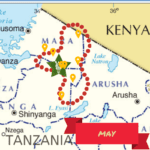
What is Happening
The herds continue to move north and as the month progresses the Grumeti River starts being very busy. Grasslands are in flower. If the rains persist the herds may be scattered throughout the central Serengeti.
As the herds move towards Lake Magadi just north of Moru and south of Mokoma the very wet road conditions prohibit the mobile camps from following along.
The Western Corridor will fill up with some animals heading north of the Seronera and most flanking the Mbalageti River in Ndoha and Dutwa Plains. Moru can also be busy.
This is the wettest month in the Serengeti.
Don’t Miss the Highlights
Action photographers stand by – huge columns of the migration, stretching 25 miles (40 km) in length are now moving at great speed.
Where to Sleep
Ubuntu⛺️ Chaka Camp (opening 15 May)⛺️ Serengeti Safari Camp⛺️ Serengeti Under Canvas⛺️ Naona Moru⛺️ Namiri Plains⛺️ Dunia⛺️ Pioneer Camp⛺️Grumeti River Camp
Combine your Great Migration African Safari with:
Take advantage of the quieter shoulder season in South Africa, Botswana, Zambia, and Zimbabwe’s best wildlife areas.
Victoria Falls is at its peak fullness.
J U N E
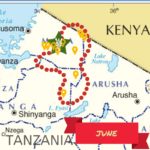 What is Happening
What is Happening
The herds are still moving and their location can be tricky to predict. By the end of June, the first Mara River crossings may happen but the mega herds are still way behind. The herds are now dispersing making the choice of accommodation a little more difficult and highly dependent on the amount of rainfall.
As the rains have stopped there may be mega herds collecting along the southern bank of the Grumeti River. Herds also trek towards the Ikorongo Game Controlled Area. The Western Corridor and Kogatenda remain good.
The plains are beautifully lush and green. The weather is cooler and drier with fewer bugs and more dust.
Don’t Miss the Highlights
The wildebeest rut is now underway. In Grumeti, the crocodiles are enjoying a feast as the wildebeest cross the river.
(Do note that the drama of Grumeti river crossings may depend on the water levels in the river as they can be very low in some years.)
Game is more spread out and long game drives can offer superb sightings.
Where to Sleep
Chaka Camp⛺️ Serengeti Safari Camp⛺️ Ubuntu⛺️ Serengeti Under Canvas⛺️ Grumeti River Camp⛺️ Ewanjan⛺️ Kirawira Camp⛺️ Faru Faru⛺️ Serengeti House⛺️ Sabora Tented Camp⛺️ Sasakwa Lodge
Combine your Great Migration African Safari with:
A great month to add a wildlife safari anywhere throughout the continent.
Gorilla trekking and island hopping can also be good.
Islands of the Indian ocean offer a great castaway experience.
As the rains stop in Botswana the risk of malaria is significantly lowered.
J U L Y
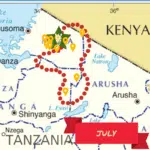 What is Happening
What is Happening
While the mega crossing into Kenya usually happens in July it isn’t set in stone. The herds are picking up speed as they loop through the Northwest Serengeti before reaching the Masai Mara. Lion prides and leopard stalk the grazers from the marsh and woodlands and cheetah enjoy the hunting grounds of the wide-open plains.
The Grumeti River is where you want to be in early July and the Mara river later in the month. Large herds can be found as far east as Lobo and the Lamai Wedge.
July is a dry and warm month.
Don’t Miss the Highlights
July should come with its own special movie trailer as it marks the start of the Mara River crossings as well as the mating season in the Serengeti. If you dream of spotting a giant Nile crocodile you are in the right place at the right time.
Where to Sleep
Mara⛺️ Faru Faru⛺️ Sasakwa⛺️ Serian Camp/Ngare Serian⛺️ Serengeti Safari Camp⛺️ Sabora Tented Camp⛺️ Serengeti Under Canvas⛺️ Nasikia Migration⛺️ Kuria Hills⛺️ Sayari Camp⛺️ Lamai Serengeti⛺️ Pioneer Camp⛺️ Serian’s Serengeti North and Lamai⛺️ Mkombe’s House
Combine your Great Migration African Safari with:
At the peak of the migration, you might want to concentrate all your energy here but wildlife watching is good throughout Southern Africa in the cool, dry winter months.
A U G U S T
What is Happening
The riverbanks are filled with vultures and marabou storks feeding on the carcasses of the wildebeest who didn’t make it. A great month for river crossings as the herds move between Tanzania’s Serengeti and the Masai Mara in Kenya.
The western half of the Masai Mara National Reserve is filling up as survivors celebrate with a feast.
Expect hot and humid weather as the dry season continues.
Don’t Miss the Highlights
This is the height of the river crossings. National reserves are open to members of the public and the community-run conservancies offer a more private experience.
Where to Sleep
Naibor⛺️ Naibosho⛺️ Mara Plains⛺️ Mara Expedition Camp⛺️ Serian’s Nkorombo⛺️ Olonana⛺️ Governor’s camp collection⛺️ Cottars⛺️ Rekero Camp
Combine your Great Migration African Safari with:
This is peak season throughout Africa.
Add a cultural experience in East Africa or enjoy the best of Southern Africa.
Go gorilla trekking in Rwanda.
S E P T E M B E R
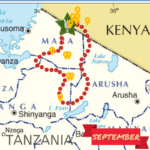 What is Happening
What is Happening
The focus is now on Kenya with the herds slowly edging eastwards through the Masai Mara as the herds spread out across the far north of the Serengeti and into Kenya’s Masai Mara.
As most of the wildebeest have crossed the Mara River the herds can be found enjoying the lush Greater Masai Mara before moving along to the private conservancies of Mara North and Olare Orok.
Herds break up into smaller groups that are spread out to make the most of both the water and the food.
The weather is hot and dry in the Serengeti and Masai Mara.
Don’t Miss the Highlights
As the month moves towards October the last of the Mara River crossings can best be viewed from the Masai Mara in Kogatende and the Lamai Wedge or Lobo.
Where to Sleep
Kichwa Tembo Bateleur⛺️ Governor’s Camps⛺️ Kicheche Mara⛺️ Nasikia Mobile⛺️ Mara Plains Camp⛺️ Mara Bushtops⛺️ Chaka⛺️ Bush Camps⛺️ Mara Expeditions⛺️ Naibosho Serengeti⛺️ Sayari Lamai camp⛺️ Mara Porini and Lion⛺️ Ubuntu⛺️ Kimondo⛺️ Olakira⛺️ Mkombe’s House⛺️ Safari Camp
Combine your Great Migration African Safari with:
A visit to Mauritius.
Add the Ruaha and Katavi National Parks in Tanzania or the Masai Mara in Kenya.
A magical time along the Garden Route and in Cape Town.
A great time for visiting the Hwange National Game Reserve in Zimbabwe.
O C T O B E R
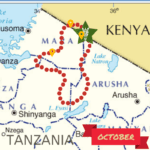 What is Happening
What is Happening
The Tanzanian side of the border is significantly quieter than the Kenyan side – the Mara Conservancies excluded – but they don’t offer good river crossings. In October the Masai Mara is a great migration safari destination.
Rains may start falling in the southern Serengeti initiating the long trek back south via Loliondo.
Expect warmer weather.
Don’t Miss the Highlights
While the Masai Mara can be very busy (it is much smaller than the vast Serengeti) the conservancies are less crowded and choosing to stay here also benefits the local Maasai communities.
With vegetation at its scarcest, this is a great month for spotting wildlife.
Where to Sleep
Perched below the Kuka Hills in a private concession in Loliondo, Klein’s Camp often has a grandstand view of the Migration⛺️ Serengeti Safari Camp is also well placed at this time of year. ⛺ Kimondo.️
Combine your Great Migration African Safari with:
At the height of peak season, we are having our heads turned by the island life again. Combine your safari with a visit to Seychelles, Mauritius or Mocambique.
Add culture to your Masai Mara safari with a visit to the local Maasai people.
Visit Zambia to spot wildlife around water holes and raft the Zambezi River.
Go chimpanzee trekking in Rwanda.
N O V E M B E R
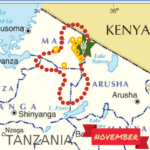 What is Happening
What is Happening
The migration can be anywhere from the south-eastern Masai Mara to the north-eastern Serengeti. The herds are picking up the pace and game now collects in the heart of the Seronera, stretching from Lobo.
River crossings are very rare.
November might bring rain and cooler weather, but it’s still a good time to see the wildebeest in the Serengeti.
Don’t Miss the Highlights
Enjoy the cooler temperatures while your safari remains on the spoor of the migration.
Where to Sleep
Migration Camp⛺️ Mbuzi Mawe Tented Camp⛺️ Four Seasons⛺️ Namiri Plains⛺️ Serengeti Safari Camp⛺️ Pioneer Camp⛺️ Serengeti Under Canvas
Combine your Great Migration African Safari with:
Still a great time to enjoy a tropical island getaway off the coast of Africa.
November is also a good time to visit Tanzania, Botswana, and the pink flamingoes flocking to Etosha in Namibia.
D E C E M B E R
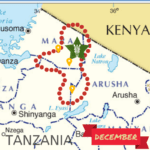 What is Happening
What is Happening
December is a month that sees the herds settling into the wet season grazing grounds of the southern Serengeti and Ngorongoro Conservation Area. At the start of the month, the herds are often still moving south. By Christmas and into the New Year, the southern plains, covered in fresh grass, are certainly the place to be. The volcanic soil is now the focus during feeds.
Expect cooler weather with short rains.
Don’t Miss the Highlights
Calving will begin again, bringing the predators. The cycle of life begins all over again.
Where to Sleep
The migration is now quite dependent on the amount of rain again. Lodges and seasonal camps in the Seronera and Ndutu areas (see January-March) once more become the focus of Migration viewing:
⛺️ Serengeti Safari Camp⛺️ Pioneer⛺️ Mwiba
Combine your Great Migration African Safari with:
A second migration in the Kalahari Dessert.
The Indian Ocean islands are all still wonderful too.
Birding is magnificent (and temperatures cooler) in Namibia.

